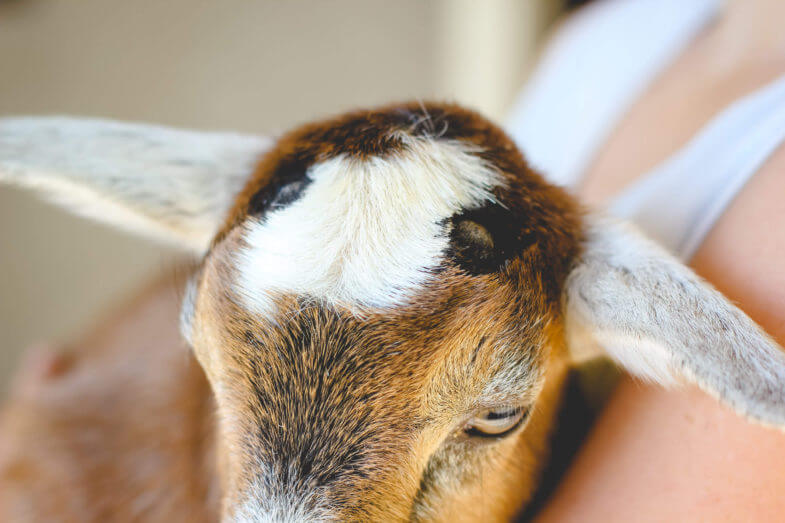
Can you actually stop horn growth with clove oil?
That was the question I had when my friend Angela from Parisienne Farmgirl shared this new research with me.
It seemed impossible. Goat horns are tough little buggers. And the old method (which involves burning the newly formed buds) was working fine for us, though to be honest, it’s the worst part of our job here.
When it came to this new clove oil disbudding method, I have to admit, I was intrigued.
Raising goats with horns can become problematic. They continually get caught in fences, and can harm/kill other goats as well as humans.
Imagine, not having to put your goats through pain, but also be able to have a safe no-horn goat farm. Would it really work?
Boy, let me tell you, you guys. I held off on writing this post for a LONG time. I needed to really test out this theory and study the science thoroughly before I presented it as a viable option to people who are looking for a more natural way to raise goats without horns. Now I’m happy to show you my research and personal experience with this method!
The science of disbudding goats with clove oil
In 2014 in Iran, a study was performed using clove oil to disbud goats and published in a Veterinary Research Forum. The results showed 100% success in stopping horn growth before it even started. The clove oil was injected into the horn bud parallel to the skull; it was not applied topically to the bud.
“Histopathological study showed that injection of clove essence caused complete necrosis of epidermis and underlying dermis with collagenolysis in horn bud tissues, 5 days after injection and then progress in healing process was observed after 10 days. According to the results of this study, it can be concluded that the injection of clove essence is an effective method to stop horn growth without any undesirable effects on clinical parameters in goat kids.” (source)
During the study, only the left horn was injected with clove oil while the right was injected with saline only, to serve as a control. Every single left horn did not grow, while the right horns all grew to normal length.
Sounds pretty amazing, huh?
The only drawback was that this study included ONLY injections. There were no results of a topical application.
Why does clove oil work so well?
Clove essential oil is distilled from the stem, bud, or leaves and has high amounts of Eugenol. Eugenol at very high percentages can be corrosive to tissues. When clove is made into an essential oil, the percentage of Eugenol is rather high (around 85%). There are other plants that have Eugenol in them when distilled into an essential oil but are a lot lower. (Basil – 15%, Cinnamon – 10%, Jasmine – 3%, Ginger – 1%)
It’s the high percentage found in Clove oil that does the job in effectively stopping cell growth within the horn base.
For everyday home usage, Clove is usually diluted before applying to reduce the strong compounds found in it. According to the Essential Oil Safety book, by Robert Tisserand, Clove essential oil is safe for human & pet topical application at a dilution of 0.5% (1 drop of oil in 2 tsp. carrier oil – like coconut or olive oil) We keep clove essential oil on hand for a natural mouthwash, clear skin, and for home cleaning. We don’t dilute it when during this disbudding method.
Which Clove oil do I recommend?
The general consensus is to find a brand that will provide you with a GCMS report and that has around 80-85% Eugenol. I used doTERRA’s clove essential oil and had successful results. CLOVE OIL ADD TO CART (free shipping)
There are lots of great essential oil companies, and I truly believe if you feel another brand is best you need to stick with your gut. For me, it came down to which worked the best. I tried a few different brands but doTERRA was the oil that I could get the best results overall whether I was using clove for dehorning or lavender for sleep. That spoke volumes to me about their purity.
How to remove goat horns naturally with clove oil
A group of “goat disbudding with clove oil” enthusiasts created a facebook group and started to try out this method. You can join the Clove Oil Disbudding Facebook Group here, though be aware, you need to read the FILES section of this group before asking any questions.
Because we only had the study as our experience and a few vets to ask advice, we had to come up with our own protocol in using this method.
The method:
-
- Amount to inject: The original study used 0.2mL for full size goats. This amount has caused significant swelling on the smaller dwarf goats. 0.1mL has been tried on the smaller goats and seems to work. 0.05mL on Nigerian Dwarfs appears to not be enough as horns grew in those goats. It is important that enough oil is injected. The original study was done on goats that got to about 66lbs. You should adjust your amounts as you feel. Some people have gone back and done a second injection if they see horns starting. (YES, this seems like a tiny amount, but it is correct)
- Size of needles to use: Lots of people in the group were using the standard 18 or 20 gauge needles, but I really wanted to use a smaller size for this injection, so I searched around and was able to find 22 gauge needles from Tractor Supply. (I purchased the 22 gauge x 1 inch needles with syringe)
- How to inject: This group has done both single location injections and multiple location injections. Below the horn bud, into the horn bud, and subcutaneously at the horn bud. It seems to be one injection site is the way to go as the oil will leak out of the previous injections sites. The angle at which to inject is VERY IMPORTANT! You want the syringe to lie parallel with the skull. Injecting straight into the bud is dangerous because underneath it lies the goat’s sinus cavity and if you inject past the bud into that, it could cause respiratory issues and even death, and you risk more issues if your oil is not the best quality. Many people from the group had a vet or vet tech assist during this injection. I felt comfortable doing this myself from my experience in nursing school.
- Which brand of oil is best? The general consensus is to find a brand that will provide you with a GCMS report and that has around 80-85% Eugenol. I used doTERRA clove essential oil and had successful results. My opinion on the matter is that the purity of the oil MATTERS. There is a lot of adulteration in the essential oil world and synthetic compounds can produce complications. doTERRA’s essential oils were recently found to be completely pure by an Essential Oil Consumer Reports facebook group.
CLOVE OIL ADD TO CART (free shipping)
- At what age should I inject? The original study says 2-5 days old. They did it at 5 days. I, personally, think that to get the right ratio of oil to horn cells it should be done as early as you can. The older they are, or the larger the horn bud, the more cells there are to reproduce, and the more chance the clove oil will not get to all of them, causing scurs.
- Is it less painful than burning? I, personally, would say yes. The kids certainly do not like getting poked, but it is not the same screaming that happens with burning, and IMMEDIATELY after the needle is out, the kid is acting 100% normal. There have been reports of swelling that appears to cause some discomfort in the kids for a day or two. You are removing a natural appendage on an animal, there will be no 100% painless, risk free, way to do this.
- Does it work? Yes, it appears the injections do work, though there have been both successes and failures, which could depend on the how the injection was performed. Topical has not had much (if any) success.
My experience removing goat horns with clove oil
There were a few people in the group who were wanting to try topical. Although I really wanted to go this route, I had two bucklings, and if you’ve owned goats before, you know that bucklings grow horns faster than doelings, because of their dominant male hormones.
I decided to inject the clove oil into the two male goats, and try topical application on the female. I also decided to inject on a day earlier than in the study.
On Day 1
I did nothing more than check their buds and assess where the starting point was. This is our adorable Nubian doeling who was sick of me taking pictures of her ?. This is a picture of her just a few hours after she was born.
On Day 3 and 4
I decided to get a head start on all their buds and start applying the clove oil topically to every baby goat. I started off by shaving their heads so the oil wouldn’t just absorb into the hair. (This was the general consensus from the members of the group)
 On Day 5
On Day 5
It was time to inject the males. I was more nervous than I have ever been with standard disbudding. I don’t know why, I guess because I had seen so many people have various issues. Some tried multiple injection points and the oil leaked out. Some had the clove oil burst out of the bud and spray into their eye (eek!), so I was definitely cautious when doing this. I made sure to have protective eyewear and from my nursing experience, I knew that a little amount could go a long way. I stuck to the study’s recommended amount, which was 0.2mL for a full size breed. (On a Nigerian, I would use 0.1mL) I prepped the bud by wiping with an alcohol swab first.
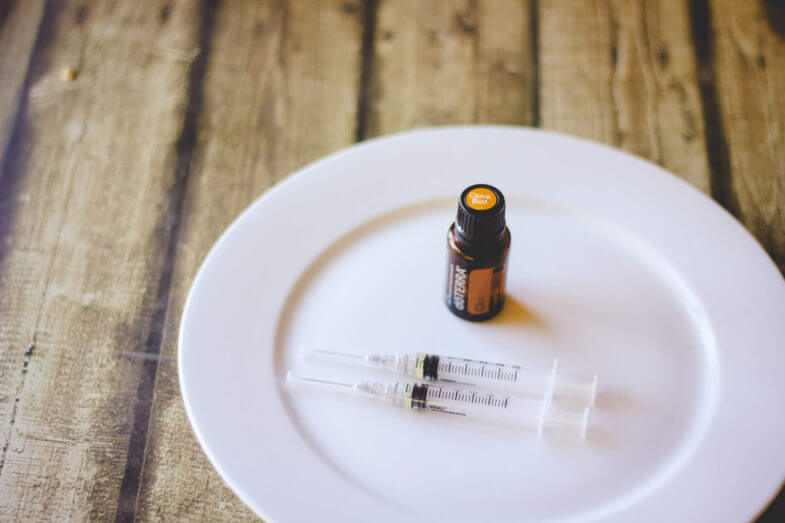
I apologize for this horrible blurry picture below! It’s tough to have a kid take the picture of a squirming baby goat. (Baby goats squirm around if you try to hold them still at all, so this little guys was confused as to why we were holding him down)
I injected from the back the best I could and it seemed to go well except for his squirming. Compared to disbudding with a hot iron, this seemed really similar in his reaction (he let out a good yelp when I injected) but then he calmed down right away. Not much different than anybody receiving any kind of injection:)
In hindsight though, I wish I would have put him in the holding box and done the injection from the front. I think that would have made a less squirmy goat and a more accurate injection.
We did the same exact method on the second male. He was less squirmy but that’s because he’s a sweetheart:) Ah, goats. You come with all sorts of different personalities, don’t you?
For the female, I continued to apply topically from Day 3
That’s pretty much it!
The results of my clove oil disbudding
Just to review, we injected each male’s buds with 0.2mL clove essential oil on Day 5, and applied only topically to the female’s buds from Day 3-14. When I applied topically, I simply had somebody hold her and I let 2-3 drops from the bottle drip directly on her buds, then I rubbed it in with my finger.
The mother of the goats didn’t reject the babies from the smell, though I was careful not to get it anywhere near their behinds as I know mothers typically sniff in this area while a baby is nursing to determine if it’s their baby. I also let Luna sniff the bottle of Clove towards the end of her pregnancy to get her used to the smell just in case she had an issue with her babies smelling like it — she didn’t.
On the males that I injected, the horns stopped growing. On the female, hers continued to grow, but at a very slow pace.
When the babies were about 4 weeks old, I realized a bigger mistake of mine. I was planning to sell these goats. We weren’t going to keep any to raise to adulthood, so I was caught in a conundrum. Would the new owners be okay with this method? Could I advertise them as “disbudded” goats? Hmmm. That was a tough one for me to figure out. I decided to leave it up to the new owners.
In the end, each new owner prefered a “real disbudding” with the hot iron, so we obliged. One thing was pretty amazing though! Since the buds on the males were as small as a 1 week old’s, I could disbud them with an iron at an older age with no problem. Also, when we disbudded the males with the iron, they didn’t hardly make a peep or act like it hurt them. And when I cut the bud off after the initial burn, it was a very pale white underneath and no blood whatsoever, which is very uncommon in male goats. So, I truly believe these buds were successfully halted in growth by only the clove essential oil.
For the female, by day 14 we knew the buds were too large and the topical simply wasn’t going to work and that we were going to need to hurry and disbud with the iron, which we did.
Words of caution & advice
Just like any kind of disbudding, there are risks involved. The primary risk is if you inject at an angle that will introduce clove oil into the sinus cavity, it will cause swelling, pain, and possible death. I’ve seen this happen in the group and it’s incredibly sad. My opinion on the matter is that the purity of the oil MATTERS. There is a lot of adulteration in the essential oil world and synthetic compounds can produce complications. doTERRA’s essential oils were recently found to be completely pure by an Essential Oil Consumer Reports facebook group.
If you don’t have a medical background, I’d highly suggest having a nurse, vet tech, or vet assist with this procedure. Although the needle is long, you are only inserting it maybe a 1/4 of an inch into the bud, no more. It’s a very small amount that you insert and a very small amount of clove oil that you inject, but it takes understanding of goat anatomy and knowhow with injections to properly do this method.
Also, the age of the baby goat matters. Somewhere between Day 3-5 is best and if you wait further, the success drops dramatically. I applied topically to all starting on Day 2, then injected on Day 5.
If you’d like to see more results from people who have tried various methods, or to ask questions, I urge you to join the Clove Oil Disbudding Facebook Group here.
Which disbudding or dehorning method is right for you?
You may want to try this method, the old method of disbudding with an iron, or you may not want to remove the horns from your goats at all. I firmly believe that a goat owner needs to do what feels right for their situation. There’s no pressure to be like anybody else, only to take care of your animals in the best way possible. I hope this tutorial helps those who are interested in learning more about their disbudding options, whether they do it this way or not:)
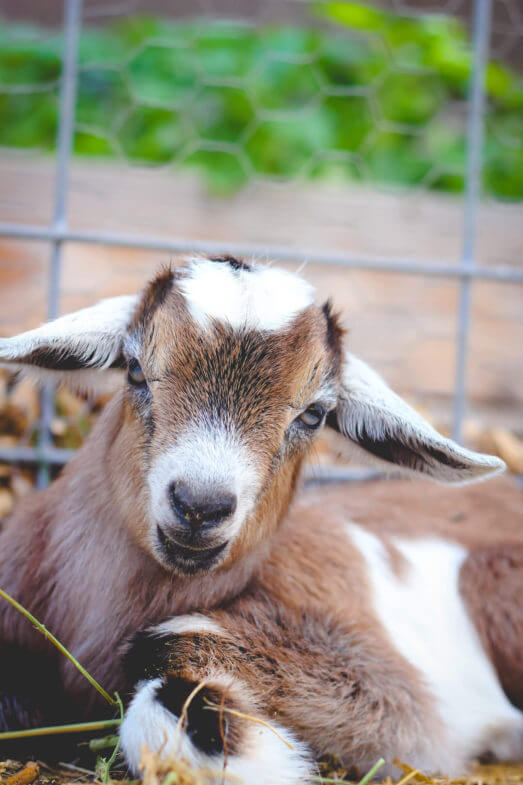
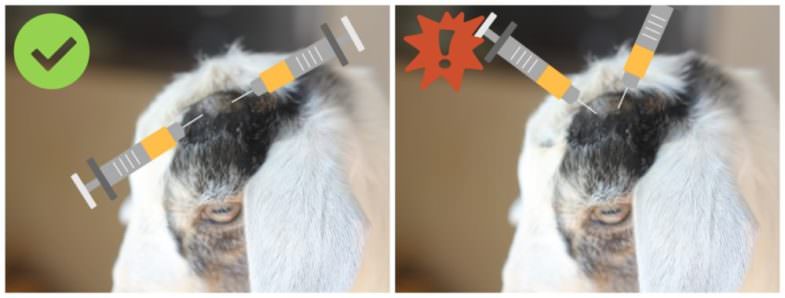
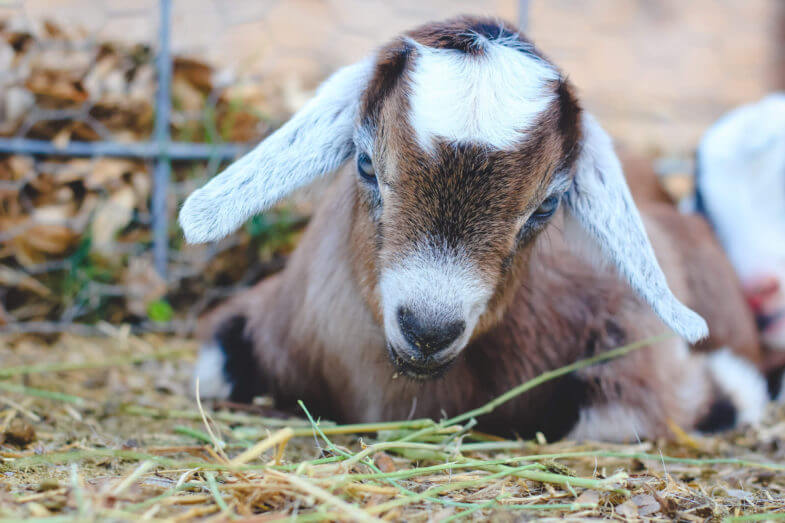
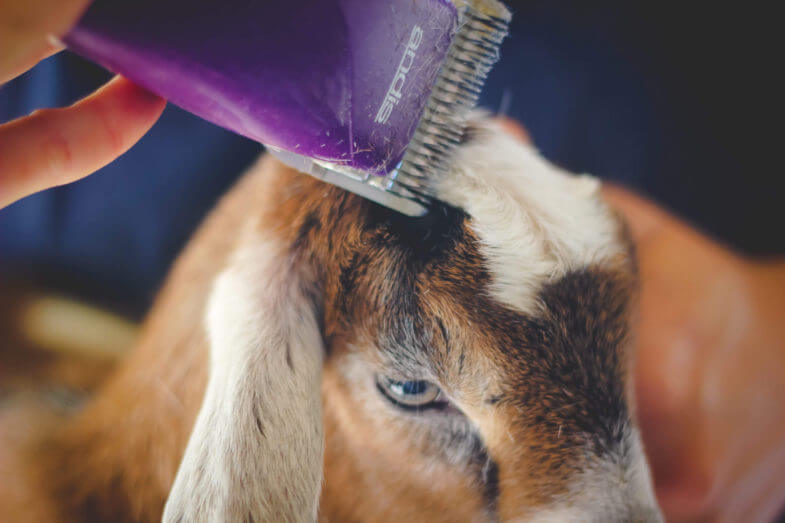
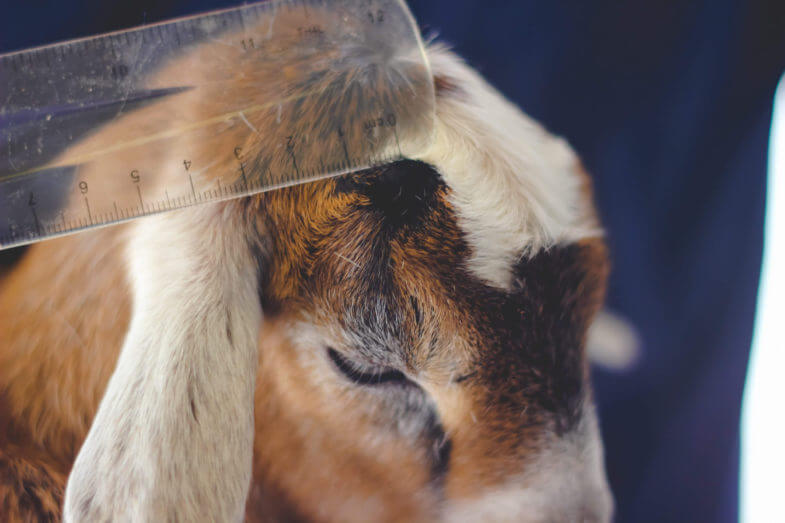 On Day 5
On Day 5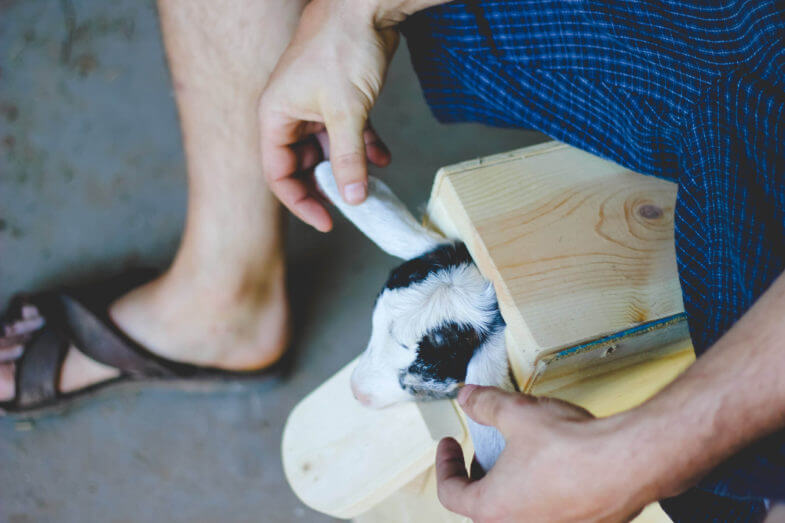
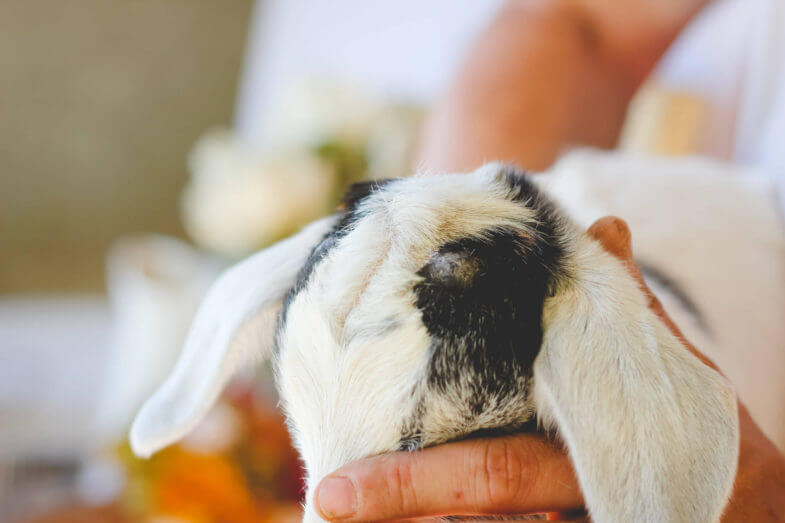
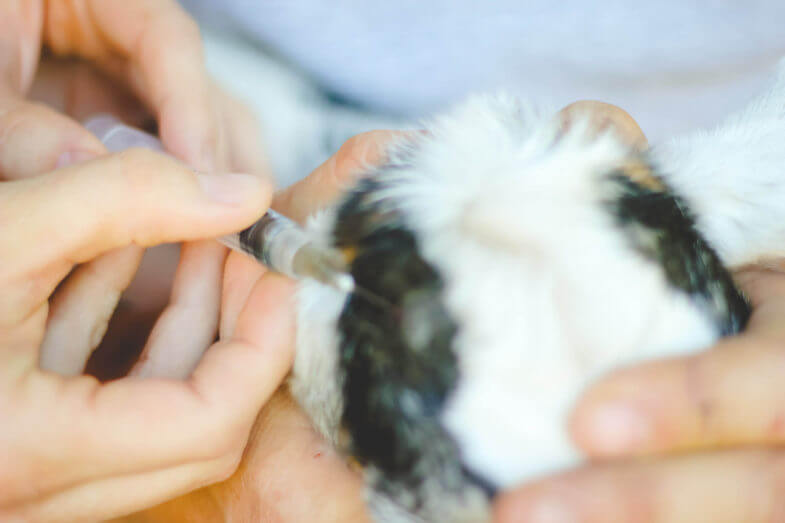
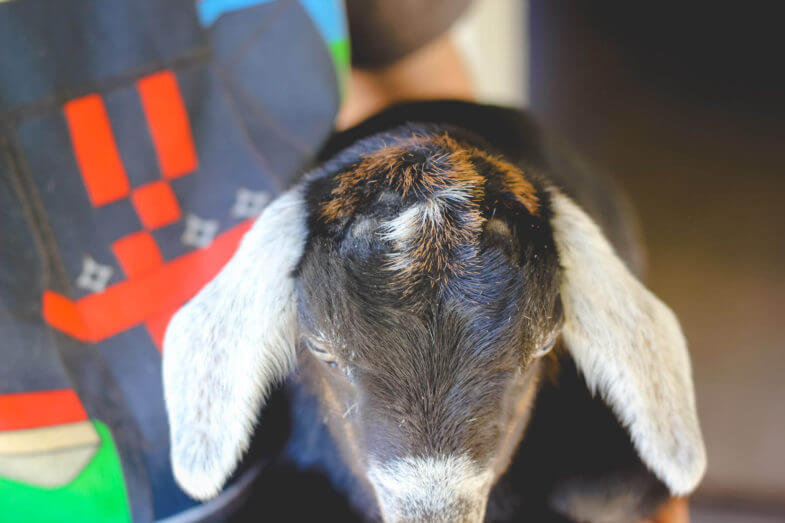
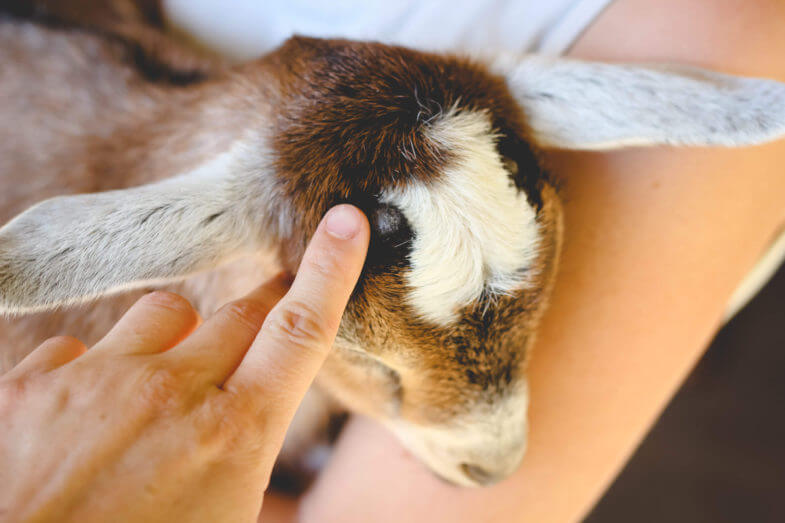
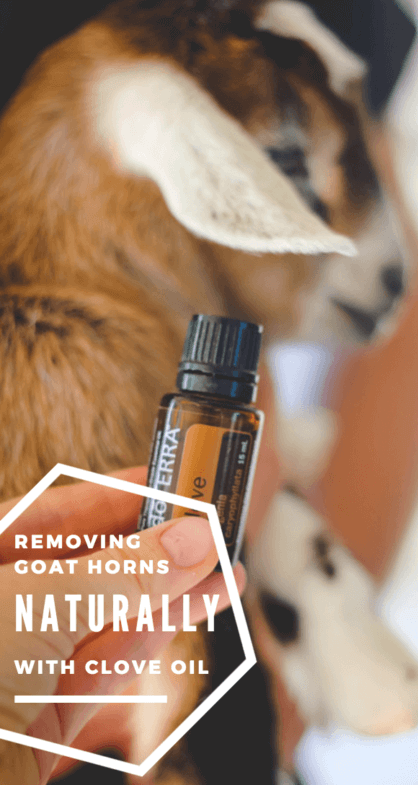

Could you please elaborate on the type of syringe and needle to use in this procedure? I read somewhere 23 G and 1/2 inch long? the use of tuberculine syringe better for volume calculation? Thank you and great web site!!
Hi Jose-
Under “The Method” section of the article it describes the needle and syringe DaNelle used.
Thank you -Bobbi (DaNelle’s Assistant)
This isn’t about the disbudding but I havent’s seen anything on this. Do you have to tattoo your registered goats/kids?
Hi Alyse-
DaNelle does tattoo her goats and her all of her babies are available to be registered through the AGS & AGDA societies, except for her Nubian Luna and her mini-Nubian Stella.
Thank you -Bobbi (DaNelle’s Assistant)
Thank you for all your great information. I just tried doing this on my babies and found that it was really hard to push the oil into base of the horn bud. Do you think we need to enter in lower, like more under the bud?
Hi Kristi-
Yes, that could work a little easier. I also would recommend joining the FB group linked in the article. They can give some great tips on how to make the process easier.
Best of luck with your goats!
Thank you -Bobbi (DaNelle’s Assistant)
This is so horrendous.
Do the males that you used this method on still show no signs of horns growing in? I’ve read a lot of things about the horns growing in later so just wanted an update! Thanks!
Hi Sadie-
For the goats in the article DaNelle did the standard burning for dehorning. She did the clove oil on them as well because she sold them and each purchaser wanted an extra precaution even though they weren’t growing back at all at 8 weeks. So I cannot tell you beyond that how successful it was. However, if you check out the FB link in the article those folks can tell you more.
Thank you -Bobbi (DaNelle’s Assistant)
What was the reason for not doing this on Willow? Or, was it because you didn’t decide to keep her till much later?
Hi Melissa-
When it was time to remove Willow’s horns, DaNelle didn’t have the right syringes in time and so she went with the old method.
Thank you -Bobbi (DaNelle’s Assistant)
Thank you!
Thank you! Curious now to see which method DaNelle uses on this next batch of kids! Especially any that the family plans to keep!
Love this information and I cannot wait to try this method of disbudding. This article is so well written and the illustrations are wonderful. I have been very apprehensive about disbudding because of the hot irons, but this gives me new options and encouragement that there are more humane ways to disbud than a hot iron. Horns are indeed dangerous to both animals and humans so you oscillate between the safety issue or the humanity issue – this resolution is what I have been looking for. I was reading the comments and found the cayenne pepper resuscitation information very interesting also. As a former Chemist, I try to use as many holistic methods as possible on my farm. I will be doing some research on that. Thank you DaNelle and Bobbi for this article.
Hi, love the method, love the write-up. Could the method be used the get rid of scurs?
Hi Darren-
I haven’t tried it on scurs so I can’t say for sure. Here is a link to a group on FB that could provide more feedback about this: https://www.facebook.com/groups/CloveOilDisbudding/
If you try it let us know how it goes!
Thank you
-Bobbi (DaNelle’s Assistant)
My question is completely unrelated to this post, but you seem like a good person to ask…I’m a Doterra user and recently added Nigerian dwarf goats to our little homestead. Would it be ok to use a drop of lemongrass on the goats for tick control? I usually apply a drop to my dog’s neck without any problems and it does seem to help repel ticks. Was wondering if I could do the same for the goats. My youngest goat is 2 months old. Thanks!
Hi Tricia-
Yep, you can use lemongrass oil on your goats.
Here are a few more articles in case you need additional natural pest control:
https://www.weedemandreap.com/homemade-fly-spray-recipe/
https://www.weedemandreap.com/homemade-bug-spray-recipe/
https://www.weedemandreap.com/essential-oils-dogs/
I hope that helps!
Thank you -Bobbi (DaNelle’s Assistant)
Have you used this method since your initial trial? If so, what have your results been?
Hello-
DaNelle has had the clove oil work successfully on 3 kids. Let us know if you give it a try and if it works for you. Thank you -Bobbi (DaNelle’s Assistant)
Been using clove oil or distilled essence since the 1960s. My granddad stumbled on this by orally giving clove distalate to cure something and noticed the kids did not have as big horns. Then he injected the buds. You are right about a 10th of a mil. No problem with goat health or disposition. Glad you found it.
How many kids has this successfully worked for you on?
Hi Jen-
DaNelle has had the clove oil work successfully on 3 kids. Let us know if you give it a try and if it works for you. Thank you -Bobbi (DaNelle’s Assistant)
Hi
Thank you so much for doing the research on this.
This season we are trying this method in place of hot iron debudding which I hate. I have just done my first boy, I’m so scared that I’ve mucked it up, I hope I haven’t!
The first bud every time I put the needle in he screamed then I let go & it fell out, I finally got it all in. The second bud was easier but some of the oil escaped.
Will I need to do it again?
I do all the farm work on our little slice of paradise & that is the first time I’ve been really nervous of doing injections. How does everyone else get on? I also watched a YouTube video on how to do it.
Hi Paula-
Hopefully you won’t have to do it again, as it should kill the tissue. If you would like more feedback from others that are going with this method here is the FB group on this: https://www.facebook.com/groups/CloveOilDisbudding/
Best of luck and Happy Goating! Thanks -Bobbi (DaNelle’s Assistant)
Sorry to post on such an old article. I’m planning on trying this when our girl kids (though with the buck we’ve selected each kid has a 50/50 shot at being polled). When I first heard about it I thought I’d only try it on one horned kid and keep it and then use an iron on any other horned kids and sell them. Now I’m over it. I understand disbudding is important but if I can avoid an iron, I will. I plan to be straightforward with buyers about the method and exchange contact info so that if the horns start to grow in the future, I’ll know not to do it again. Fortunately, our doe isn’t even weaned yet so there may be more info on long term effects by the time she kids. If they exhibit horn growth as adults, future injections may be effective? Like a vaccine booster? I’m just ecstatic to not have to burn baby animals.
Hi Deborah-
To be honest, I don’t know enough about the use of clove oil on adult goats, as I have never seen this used on adult goats, nor can I find any studies on it. All I can say is that dehorning adults is not something I do because of the risks, but that’s just me personally, and in reference to burning and banding. When an adult is dehorned it exposes the frontal sinuses. The area has to be dressed, kept immaculate, and watched closely for any signs of infections or problems. I am sorry the answer isn’t a better one. I am assuming (and this is just a personal assumption) is that you could try the injections as the goat matures, as I don’t see that the actual clove oil will hurt the goat in anyway, and if it works, great! Just be amazingly cautious with the area as the horn begins removal. Infection, etc. can still occur, although perhaps the clove oil can help with that too. If you do decide, on your own, to try this, I am very curious to know your results. Please keep us updated! And as always take the very best possible care of your goats, which it sounds like you already do! Thank you for the question, again I apologize for not having a better answer. Thank you and Happy Goating! -Bobbi
We have both horned and polled Myotonics. It is not always obvious which kids get horns and which don’t until the are a few weeks old. I had a round headed doeling that I was sure was polled. Her triplet siblings (m & f) both had obvious horns by 2 weeks. She was the bigger doeling. I started to feel born point emerging after 3 weeks. If it was a polled goat and you injected clove oil would there be a problem?
Hi Mona-
I can’t see how injecting the clove oil would cause a problem. Being an essential oil, with little to no side effects, this should be ok to properly inject into the area where you feel the buds coming in. Just don’t wait too long to debud your goat as this can cause complications. I hope this helps and your kids are doing well. Thanks for reading and posting! Happy Goating! -Bobbi
For someone new to getting goats, I have no idea how to do any of this. I wouldn’t want any of my animals or grandkids to get hurt from horns. Is this something I can get done at the vet or do people offer a service for it to be done???
I’m sure I could do it if I knew what to do. Where would one learn how to disbud a goat??
Hi Terry. Here is another article that I wrote about removing horns (but without clove oil). I hope it helps!
DaNelle
https://www.weedemandreap.com/how-disbud-dehorn-baby-goat/
Do you inject in front and back of the bud, or just front or back? I only injected the back,seems they are growing. Oops I think I did it wrong. They are 3 weeks old now. SHould we burn them off now?
Only one injection or else it drips out. If they grow bigger I would disbud with the iron.
Hi Danelle, this is a wonderful post! Thanks! Is there anyone who has tried thia with calves. I need to know the dosage for a mini jersey calf…& whether it actually works for cattle. I’ve searched to no avail. Any links or info would be much appreciated.
So far this kidding season I have used clove oil injections on three Nigerian kids, all about a week apart. The first two were bucklings. Some of the clove oil leaked out the injection hole and it was difficult to tell how much stayed in. On the second buck we repeated the injections 24 hrs later (so once on day 3 and then once on day 4). One horn showed some growth after a few days so we ended up using the iron but the other horn did not grow. The last kid was a doeling. We did the clove oil injections on day 5. It seemed to go smoothly until we let her up: she tried to walk and fell over. I picked her up and she was hyperventilating and her legs were limp. Within minutes she closed her eyes and her head went limp. I sat there holding her as she was dying and tried hard to think through what could possibly have gone wrong. I had kept the needle horizontal with her skull so I knew I had not injected the oil into her sinus cavity. There was some bleeding on one side so I wondered if I had hit a blood vessel. She was still breathing but just barely. I had my daughter get the bottle of cayenne pepper as a last resort and we pried her mouth open and put a good sized pinch far back on her tongue. After a minute or so she opened her eyes. She was not at all pleased with what was going on in her mouth! She lifted her head and made some unhappy noises and then she tried to move her legs. It was about 15 minutes before she was able to walk again but other than being a little sluggish for several hours she was fine. I still have no idea what happened and, needless to say, we did not repeat the clove oil the following day. I have three more Nigerians due to kid in the next few weeks and I am not yet sure whether I will try this again. Maybe only with the bucklings…
Hi, I spent years as a phlebotomist and have given a lot of goat injections too. This little gal had a drop in blood pressure and a kind of shock. Corn syrup or molasses on her tongue would have also worked well. And like people, tipping her upside down to get blood to her head. Some people have a similar reaction and some goats are notorious for shocking out during injections. She will probably be vulnerable every time she is vaccinated . I’d like to know more about your experiences as I am considering using the clove oil.
anyone know if this will work on cattle?
How were the females horns when you disbudded her at two weeks old, after topical clove oil treatment? Any different than few day old babies?
They still grew with the topical application.
HimDaNelle! I have three bucklings I want to try this on. Can you confirm the amount of oil you injected? Also I know the angle is from the side and not straight down, but did you only inject from one spot or multiple spots?
Yes, I used that amount of oil.
DaNelle this post was a while back, but I hope this question still reaches you. On your instruction you show two injection sites (three if you count the inncorrect angle of down into horn bud)
Are there two injections given? One on each side? Or are you just showing it can be done from either side?
Can you also confirm the amount you injected? Going to try this with one of my five bucklings this weekend, so hoping you can get back to me in time.
Thanks for posting this! Had never heard of it before.
Just one injection. If you do two, then it’ll squirt out the other hole:) Yes, I used 0.1 mL
Love this post! Are you going to do standard or clove disbudding on your next set of kids?
Hi! Thanks for this thorough description. I am planning to try this method with at least several kids this season. Question: did you inject the whole amount into a single injection site on each horn bud?
Hi Bevyn,
Yes, I did:)
What are the chances of the baby goat having an allergic reaction from the injection?
Fairly low, as goats aren’t typically allergic to anything. But it’s always a possibility.
You have taught me something today that I never even realized happened. I never knew of the risk of horns on a goat, even though I have witnessed them somewhat getting caught in a fence, it just never occurred to me, a risk. I love goats, wish my place was big enough for them….really my husband would add a flock of ducks to our backyard farm before any other animal. Great post, very educational.
You are amazing! My family can’t stand disbudding! My must try this!!!!!!! Love you and your blog!!
Thank you!!
That’s is so interesting. I might try it. I wonder if it works in sheep. I’m South of the Valley and ended up taking 10 of the Jacob sheep from the Reniessance Festival this year. The petting zoo guy retired. Anyway, one of the ewes was pregnant and I got another ewe and I will be breed the others this fall. Would be interesting to know if it works for them as well since they can get up to 3 sets of horns.
Seriously!!! Man, I’m so into this method…next year when I have more babies. You’re absolutely spot on when you say that disbudding is the hardest part of having goats. HATE it. Do it, but HATE it. Can you take care of testicles this easy? HAHAHA!!!
Haha, no definitely not testicles!
I LOVE your blog so much. It’s like you know just want I need to research next. 🙂
That’s the best compliment ever!
WOW GIRL!
You rocked the research and attempt! THANK YOU! Cause I was so curious if this would work but would have never gone to such research.
You’re cool girl!
Thanks! Love you!